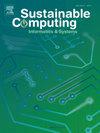Life cycle assessment of digital memories: The memristor’s environmental footprint
IF 5.7
3区 计算机科学
Q1 COMPUTER SCIENCE, HARDWARE & ARCHITECTURE
引用次数: 0
Abstract
Memristor technologies, pivotal in the evolution of energy-efficient digital devices, have the potential to revolutionize fields like non-volatile memories, hardware cryptography, neuromorphic computing and artificial intelligence acceleration. This study applies Life Cycle Assessment (LCA) methodology to analyse the environmental impact of five memristor designs, focusing on materials and manufacturing processes. The analysis adheres to ISO 14040–44 standards and employs the ReCiPe methodology to evaluate 18 environmental impact categories, emphasizing categories such as freshwater ecotoxicity and global warming potential. The results highlight significant variations in environmental impacts across the designs, largely attributed to differences in active layer materials and manufacturing processes. Molybdenum exhibits the highest impact, particularly in freshwater ecotoxicity, while SiO₂ demonstrates the lowest overall impact. Manufacturing processes like sputtering and photolithography carried out at laboratory scale contribute disproportionately to energy consumption and environmental damage, suggesting that upscaling production to industrial efficiencies is mandatory to mitigate these impacts. Furthermore, several materials required for memristor fabrication are listed as critical by the International Energy Agency (IEA), raising concerns about supply security, resource scarcity and environmental sustainability. This analysis serves as a foundational step for optimizing memristor technologies, balancing performance demands with environmental stewardship. To the best of our knowledge, this is the first comprehensive Life Cycle Assessment that compares multiple memristor architectures using real laboratory data and evaluates their environmental impacts. This work provides a methodological foundation for future sustainability assessments in the context of emerging memory technologies.
数字记忆的生命周期评估:忆阻器的环境足迹
忆阻器技术是节能数字设备发展的关键,有可能彻底改变非易失性存储器、硬件密码学、神经形态计算和人工智能加速等领域。本研究应用生命周期评估(LCA)方法分析五种忆阻器设计的环境影响,重点是材料和制造工艺。该分析遵循ISO 14040-44标准,并采用ReCiPe方法评估了18个环境影响类别,强调了淡水生态毒性和全球变暖潜力等类别。结果强调了不同设计对环境影响的显著差异,主要归因于活性层材料和制造工艺的差异。钼表现出最大的影响,特别是在淡水生态毒性中,而二氧化硅表现出最低的总体影响。在实验室规模上进行的制造过程,如溅射和光刻,对能源消耗和环境破坏造成了不成比例的影响,这表明必须提高生产规模以提高工业效率,以减轻这些影响。此外,国际能源机构(IEA)将制造忆阻器所需的几种材料列为关键材料,这引起了人们对供应安全、资源稀缺和环境可持续性的担忧。这种分析是优化忆阻器技术、平衡性能需求和环境管理的基础步骤。据我们所知,这是第一个全面的生命周期评估,使用真实的实验室数据比较多种忆阻器架构,并评估其对环境的影响。这项工作为未来在新兴存储技术背景下的可持续性评估提供了方法学基础。
本文章由计算机程序翻译,如有差异,请以英文原文为准。
求助全文
约1分钟内获得全文
求助全文
来源期刊

Sustainable Computing-Informatics & Systems
COMPUTER SCIENCE, HARDWARE & ARCHITECTUREC-COMPUTER SCIENCE, INFORMATION SYSTEMS
CiteScore
10.70
自引率
4.40%
发文量
142
期刊介绍:
Sustainable computing is a rapidly expanding research area spanning the fields of computer science and engineering, electrical engineering as well as other engineering disciplines. The aim of Sustainable Computing: Informatics and Systems (SUSCOM) is to publish the myriad research findings related to energy-aware and thermal-aware management of computing resource. Equally important is a spectrum of related research issues such as applications of computing that can have ecological and societal impacts. SUSCOM publishes original and timely research papers and survey articles in current areas of power, energy, temperature, and environment related research areas of current importance to readers. SUSCOM has an editorial board comprising prominent researchers from around the world and selects competitively evaluated peer-reviewed papers.
 求助内容:
求助内容: 应助结果提醒方式:
应助结果提醒方式:


